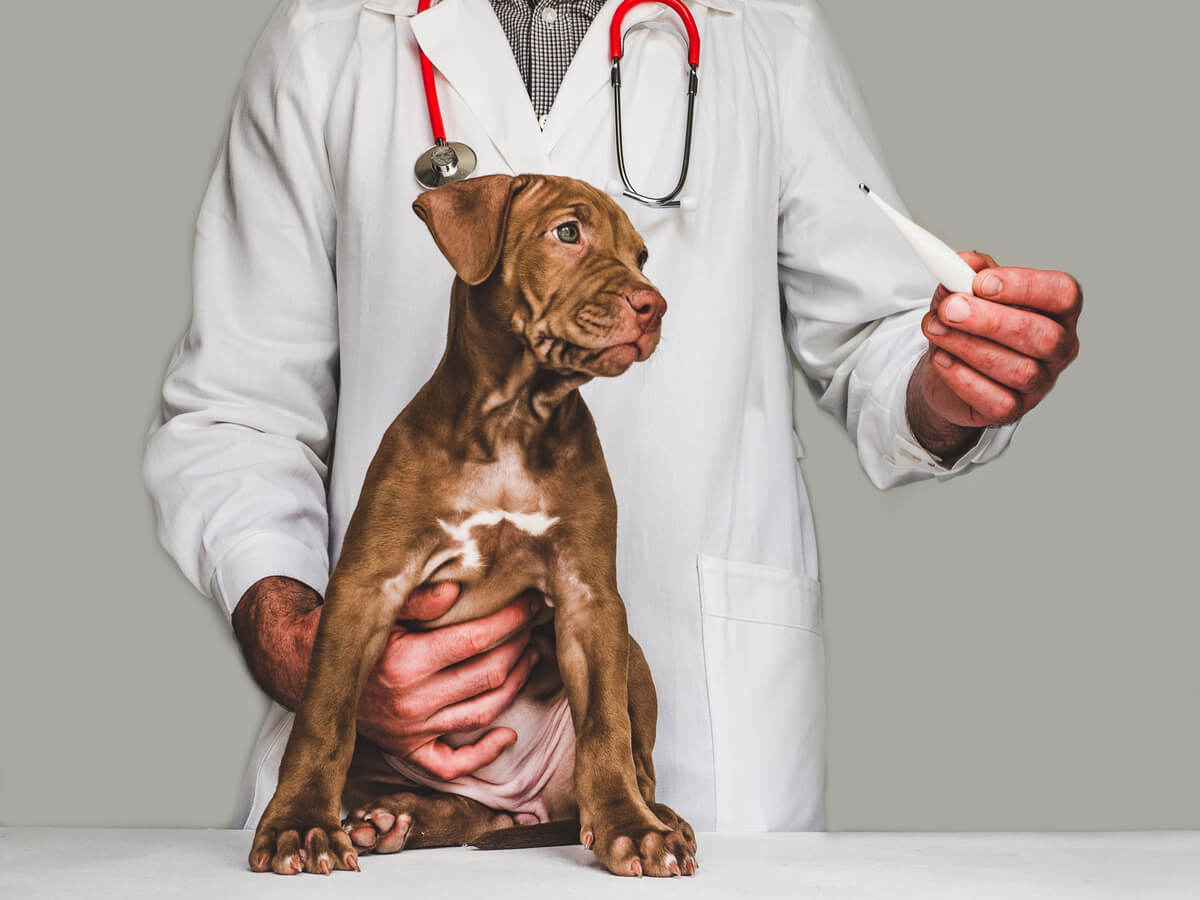Facial Swelling in Dogs: Causes, Symptoms and Treatment

Although the concept of facial swelling in dogs may seem simple, the different causes of the problem aren’t. Likewise, the facial areas that are affected by this condition can be different. Furthermore, the rate at which the swelling develops – or whether it increases and decreases at a particular rate – can also vary.
Facial swelling in dogs is nothing more than edema in some part of the face or all of it, which, moreover, may or may not be symmetrical. This effect can be produced for several reasons that we will explain below, as well as possible treatments for facial swelling in your dog.
Causes and symptoms of facial swelling in dogs
Facial swelling in dogs can have many precursors. It is the consequence of some underlying disease, intoxication, or adverse reaction of the organism. Along with the swollen face, other symptoms related to certain conditions may appear, such as ataxia, lethargy, apathy, or loss of appetite.
Allergic reaction and facial swelling in dogs
Facial swelling is usually a very common sign when a severe allergic reaction occurs. This swelling occurs abruptly and suddenly, after an insect bite, vaccines, drugs, certain foods, pollen, exposure to toxins, and other allergens that may be in the environment.
Allergic reactions are an exaggerated response of the body to substances that, in theory, shouldn’t be harmful. In general, these situations usually produce hives, itching or pruritus, and an organic inflammatory response, especially in the facial region.
The inflammation tends to be localized around the eyes and muzzle, but can also affect the neck. Occasionally, the swelling is such that the dog has difficulty breathing and may go into convulsions.
Although the vast majority of allergic reactions don’t usually go further, it’s sometimes considered a veterinary emergency situation.

Dental health
Other times, the cause of facial swelling in dogs is due to poor dental health or a specific problem. When the swelling appears in the face region – in the jaw area or under the eyes – an abscess with pus may have developed.
Occasionally certain foreign bodies can become lodged in the gums or teeth. Allowing this obstruction to remain in the mouth for too long is counterproductive, as it encourages bacterial growth and poor oral hygiene.
Gum infections, broken teeth, periodontal disease, and other mouth lesions can cause the dog’s face to swell. Other common clinical signs in these cases are bad breath, pain, or bleeding gums.
Insect bites
Stings from some insects such as bees can cause facial swelling. In most cases, this happens because the dog has tried to bite the flying insect, so when it succeeds it gets a terrible surprise. This doesn’t usually pose a serious danger to the pet, although it’s necessary to make sure that the inflammation doesn’t prevent it from breathing.
Tumors
Tumors in dogs, cancerous or not, can also develop on the face. Facial, mouth or throat tumors are related to swelling in the cephalic area. In addition, canines may develop tumors in the eye socket and cause the eye to protrude.
Trauma
Trauma is another common cause of a swollen face in dogs. Blows or wounds can become infected and cause swelling. Similarly, a blow can cause that part of the body to swell.
Treatment of facial swelling in dogs
Since this is a condition caused by other factors, even though it can be treated with various anti-inflammatory drugs, it’s best to find the cause. This means that the pathology behind the swelling must be addressed.
When we don’t know if the dog is allergic to anything – and we do know that it hasn’t been the victim of an insect or animal bite – then the veterinarian will start dietary tests to try to find the cause. However, there are specific tests to find out what type of allergy a dog is suffering from.
Intradermal techniques or blood tests can be used to detect allergic reactions in dogs.
If the dog has been bitten or has suffered some other type of trauma, the most common treatment is antibiotics and anti-inflammatory drugs. Thus, the symptom is treated and, in addition, possible existing or potential infections are tackled.
If the inflammation isn’t generalized and only one area of the face is affected, it may be a tumor or dental problem. If this is suspected, the veterinarian will inspect the pet’s teeth and gums to determine the best treatment.
Finally, when dealing with possible tumors, the first step is to perform a biopsy to determine the type of tumor and then to treat the neoplasm as accurately and effectively as possible. From chemotherapy to radiotherapy, there are many possible approaches. According to certain research, metronomic therapy is one of the most promising fields in this field.

Although it depends on the origin of the inflammation, in general, this condition has a good prognosis and a very rapid recovery. Depending on the cause, your veterinarian may want to give some advice to prevent a recurrence. Follow the indications and your dog will be as good as new in no time.
All cited sources were thoroughly reviewed by our team to ensure their quality, reliability, currency, and validity. The bibliography of this article was considered reliable and of academic or scientific accuracy.
- Burke, A. (2021). Dog allergies: symptoms and treatment. American Kennel Club. Consultado el 15 de marzo de 2023. https://www.akc.org/expert-advice/health/dog-allergies-symptoms-treatment/
- Correal, M., Bortolotti, R. & Camplesi, A. (2017). Terapia metronómica en el manejo del paciente veterinario con cáncer. CES Medicina Veterinaria y Zootecnia, 12 (3), 195-210. http://www.scielo.org.co/scielo.php?script=sci_arttext&pid=S1900-96072017000300195
- Ericson, S. & Kurol, J. (1988). Resorption of maxillary lateral incisors caused by ectopic eruption of the canines: a clinical and radiographic analysis of predisposing factors. American Journal of Orthodontics and Dentofacial Orthopedics, 94(6), 503-513. https://pubmed.ncbi.nlm.nih.gov/3195514/
- Fries, W. (2021, November 7). Dog Facial Swelling: Causes and Treatment. WebMD. Consultado el 5 de abril de 2023. https://pets.webmd.com/dogs/my_dog_has_swollen_face
- Gold, R., Oliveira, F. & Pool, R. (2019). Zygomatic arch parosteal osteosarcoma in dogs and a cat. Veterinary Pathology, 56(2), 274–276. https://doi.org/10.1177/0300985818798110
- Leon, K., del Ángel, J., Barbosa, M. & Quijano, I. (2014). Caracterización de la enfermedad periodontal en perros. Universidad Autónoma del Estado de México. http://ri.uaemex.mx/handle/20.500.11799/58495
- Mendoza, K., Mantra, S., Behr, M. & Klippert, L. (2001). Facial swelling associated with impaction of the deciduous and permanent maxillary fourth premolars in a dog with patent ductus arteriosus. Journal of Veterinary Dentistry, 18(2). https://journals.sagepub.com/doi/abs/10.1177/089875640101800203?journalCode=jovb
- Munro, H. M. C. & Thrusfield, M. V. (2001). Battered pets: non‐accidental physical injuries found in dogs and cats. Journal of Small Animal Practice, 42(6), 279-290. https://pubmed.ncbi.nlm.nih.gov/11440397/
- Shmuel, D. L. & Cortes, Y. (2013). Anaphylaxis in dogs and cats. Journal of Veterinary Emergency and Critical Care, 23(4), 377-394. https://pubmed.ncbi.nlm.nih.gov/23855441/
- The People’s Dispensary for Sick Animals. (s.f.). Dental disease in dogs. Consultado el 16 de marzo de 2023. https://www.pdsa.org.uk/pet-help-and-advice/pet-health-hub/conditions/tooth-and-gum-disease-in-dogs
- Sterk, M. (s.f.). Vet What to do with insect bites on a dog. Veterinary Emergency Group. Consultado el 27 de marzo de 2023. https://veterinaryemergencygroup.com/blog/insect-bite-on-dog/
- Verlinden, A., Hesta, M., Millet, S. & Janssens, G. P. J. (2006). Food allergy in dogs and cats: a review. Critical reviews in food science and nutrition, 46(3), 259-273. https://pubmed.ncbi.nlm.nih.gov/16527756/
This text is provided for informational purposes only and does not replace consultation with a professional. If in doubt, consult your specialist.